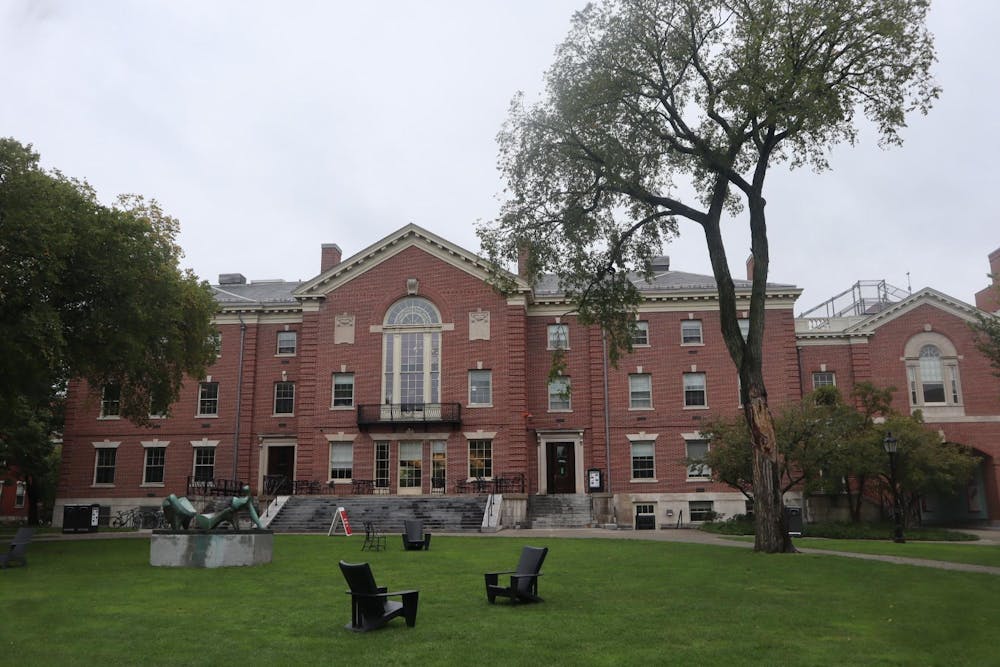When Alex Lee ’25 first arrived at Brown, he had zero intention of competing on the mock trial team. Unimpressed by his high school experience with the extracurricular, it took a lot of convincing from a friend for him to consider joining Brown’s team.
“I wouldn’t have done it had he not basically dragged me into auditions,” said Lee.
Lev Sheinfeld ’25 felt similarly about a cappella — it was something he had done in high school, but during the year he spent at Emory University before transferring to Brown, he didn’t engage with the scene at all. That changed when he was introduced to the performing arts scene at Brown.
“I remember going from not really thinking I was going to do a cappella to being very invested in being a part of this really strong foothold, a community," Sheinfeld said. After a rigorous audition process, Sheinfeld became a member of the Jabberwocks his sophomore year.
Students interested in both Brown Mock Trial and the Jabberwocks have to go through lengthy, intense application processes before joining.
Just to audition for Mock Trial, students must attend info sessions and office hours, prepare a speech and determine how to portray a witness.
The Jabberwocks has instituted not one, but two rounds of auditions — the first is just five minutes, including a range test and a solo, as is standardized across the nine a cappella groups that compose the Intergalactic Community of A Cappella at Brown University. Then, the groups diverge in their callback processes. For the Jabberwocks, there’s a “whole process of both musically and socially getting to know them,” according to Sheinfeld. This includes taking potential recruits out to meals, hosting social events for those who receive a callback and inviting them to Jabberwocks performances.
Each semester, the number of auditions can fall anywhere between 65 and 80 people, with only about 15 to 20 making it to the callback round, Sheinfeld said. They’re ultimately looking to fill between three and five spots.
While the audition process can be rigorous, “the flip side of that is that it allows for a richer, tighter community,” Sheinfeld said, adding that it allows students to challenge themselves and step out of their comfort zones.
Josie Diaz ’25, a member of the a cappella group Harmonic Motion, echoed Sheinfeld’s sentiment. “These spaces have been so rewarding to work in because everyone is doing it just out of their own passion, and people take them super seriously,” Diaz said.
Lee was initially surprised by the application process for clubs at Brown. It was nothing like what he had experienced in high school. “There was this push to try everything all at once,” he said. “There is the pressure to achieve.”
For Tucker Gibbs ’27, his role in the Model United Nations Secretariat parallels his desire to go into diplomacy. Comprising around 100 students, Brown Model UN has two main branches: the Brown University Simulation of the United Nations and the travel team.
BUSUN is a conference that welcomes approximately 750 high school students to campus annually to discuss and simulate UN committees. The travel team competes in eight conferences throughout the year and is composed of 20 to 25 students.
Model UN accepts all students who are interested, but Gibbs says that the club is trying to make the travel team more “competitive” while still maintaining an “inclusive atmosphere.”
To do this, the club offers an extra meeting during the week for students who are interested in competing on the travel team. Attendees are then guaranteed the opportunity to participate in at least two conferences.
“People who care will come, so we don’t need to be exclusive,” Gibbs said. “We’ve figured out that you don’t necessarily need to be cutthroat in order to be competitive.”
On campus, pre-professional clubs are known for their competitiveness.
“There are pre-professional clubs in consulting, finance and tech — but they are definitely competitive which people get frustrated with,” Diaz said. In addition to her role on Harmonic Motion, Diaz is a peer career advisor at the Center for Career Exploration.
Diaz noted that while these exclusive clubs allow students to re-apply after getting feedback, the application processes are “a bit harmful.”
The Herald’s 2023 annual poll found that 48% of the general student body had been rejected from a club.
Of the students studying humanities, around 53% had been rejected from at least one club on campus. Of those studying social sciences, which includes economics concentrators, around 56% said they had been rejected. These rates are both over 10% higher than the portion of life science students who reported being rejected from a club — around 41%.
“It parallels the unfortunate circumstances of wanting experience but not being let into the spaces where one gains their first experiences,” Diaz said.
Other schools, like Harvard and Stanford University, have notoriously competitive club applications. At Harvard, each semester students participate in the “comping” process, short for “competency,” instead of submitting an application to a club. There are two forms of comping. One is where students will complete a list of requirements for a club, such as writing sample articles for a publication or coding a program. The other is known as “competitive comping,” where students are evaluated against one another to gain admission into more selective clubs.
According to Lee, whose friends at Harvard went through the comping process, it seems “way more intense” than anything that exists at Brown.
At Stanford, the Office of Student Engagement had to institute new rules in January 2022 that prohibited clubs from limiting “membership based on competitive applications” after students raised concerns over club culture on campus, according to an article published by The Stanford Daily.
Though Lee and Sheinfeld admit that their clubs are considered competitive, both find that this is not reflected in the dynamics within the club after admissions. “The group is a really fun, really passionate group of people who love to sing,” said Sheinfeld.
“We practice maybe six hours a week, which is a lot,” said Lee. “And by competing together and practicing together, I’ve gotten to get really close with my team.”
“There are so many options for getting involved at Brown,” Diaz said. “Beyond that, clubs also connect with upperclassmen and a mix of students with different experiences who you can lean on as role models,” she continued.
Maya Nelson is a senior staff writer covering undergraduate student life. She’s interested in studying either English or Literary Arts and loves to read sci-fi and fantasy in her free time. She also enjoys playing guitar, crocheting and spending an unreasonable amount of time on NYT Spelling Bee.

Hadley Carr is a university news editor at The Herald, covering academics & advising and student government.





